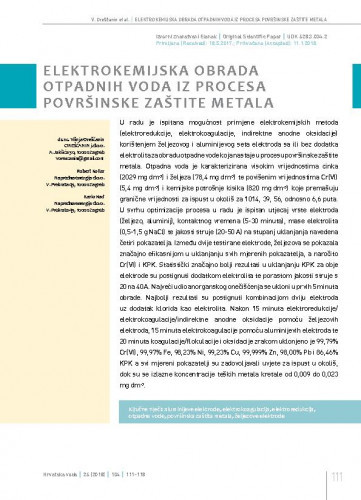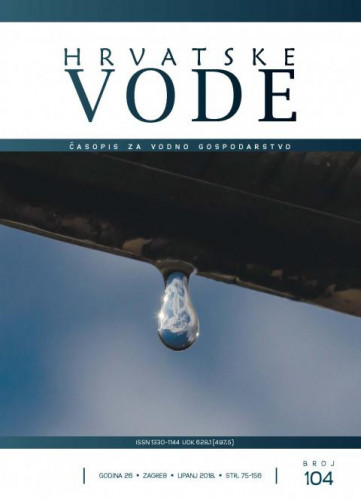U radu je ispitana mogućnost primjene elektrokemijskih metoda (elektroredukcije, elektrokoagulacije, indirektne anodne oksidacije) korištenjem željezovog i aluminijevog seta elektroda sa ili bez dodatka elektrolita za obradu otpadne vode koja nastaje u procesu površinske zaštite metala. Otpadna voda je karakterizirana visokim vrijednostima cinka (2029 mg dm-3) i željeza (78,4 mg dm-3) te povišenim vrijednostima Cr(VI) (5,4 mg dm-3) i kemijske potrošnje kisika (820 mg dm-3) koje premašuju granične vrijednosti za ispust u okoliš za 1014, 39, 56, odnosno 6,6 puta. U svrhu optimizacije procesa u radu je ispitan utjecaj vrste elektroda (željezo, aluminij), kontaktnog vremena (5-30 minuta), mase elektrolita (0,5-1,5 g NaCl) te jakosti struje (20-50 A) na stupanj uklanjanja navedena četiri pokazatelja. Između dvije testirane elektrode, željezova se pokazala značajno efikasnijom u uklanjanju svih mjerenih pokazatelja, a naročito Cr(VI) i KPK. Statistički značajno bolji rezultati u uklanjanju KPK za obje elektrode su postignuti dodatkom elektrolita te porastom jakosti struje s 20 na 40 A. Najveći udio anorganskog onečišćenja se ukloni u prvih 5 minuta obrade. Najbolji rezultati su postignuti kombinacijom dviju elektroda uz dodatak klorida kao elektrolita. Nakon 15 minuta elektroredukcije/elektrokoagulacije/indirektne anodne oksidacije pomoću željezovih elektroda, 15 minuta elektrokoagulacije pomoću aluminijevih elektroda te 20 minuta koagulacije/flokulacije i oksidacije zrakom uklonjeno je 99,79% Cr(VI), 99,97% Fe, 98,23% Ni, 99,23% Cu, 99,999% Zn, 98,00% Pb i 86,46% KPK a svi mjereni pokazatelji su zadovoljavali uvjete za ispust u okoliš, dok su se izlazne koncentracije teških metala kretale od 0,009 do 0,023 mg dm-3..; The paper investigated a possibility of implementing electrochemical methods (electroreduction, electrocoagulation, indirect anodic oxidation) by using iron and aluminium electrode sets, with or without the addition of electrolytes for treatment of wastewater generated in the process of surface protection of metals. The wastewater is characterized by high values of zinc (2029 mg dm-3) and iron (78.4 mg dm-3) as well as increased values of Cr(VI) (5.4 mg dm-3) and chemical oxygen demand (820 mg dm-3) that exceed limit values for discharge into the environment by 1014, 39, 56 and 6.6 times, respectively. In order to optimize the process, the paper investigated the impact of electrode type (iron, aluminium), contact time (5-30 minutes), electrolyte mass (0.5-1.5 g NaCl) and amperage (20-50 A) on the removal level of the stated four indicators. Of the two tested electrode types, iron electrodes proved to be significantly more efficient in the removal of all measured indicators, in particular Cr(VI) and COD. A statistically significant improvement of the results in COD removal for both electrode types was achieved by the addition of electrolytes and increased amperage from 20 to 40 A. The majority of inorganic pollution is removed in the first 5 minutes of treatment. The best results are achieved by a combination of the two electrode types, with the addition of chloride as an electrolyte. After 15 minutes of electroreduction / electrocoagulation / indirect anodic oxidation by iron electrodes, 15 minutes of electrocoagulation by aluminium electrodes and 20 minutes of coagulation / flocculation and oxidation by air, 99.79% Cr(VI), 99.97% Fe, 98.23% Ni, 99.23% Cu, 99.999% Zn, 98.00% Pb and 86.46% COD were removed. All measured indicators complied with the conditions for discharge into the environment whereas all output concentrations of heavy metals ranged from 0.009 to 0.023 mg dm-3.
Sažetak
Dio sveska

